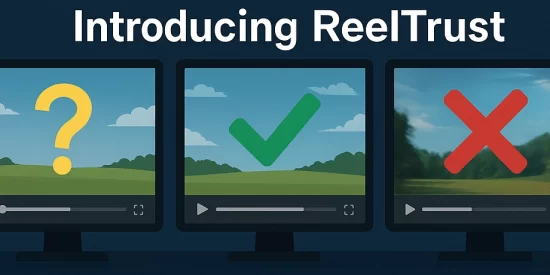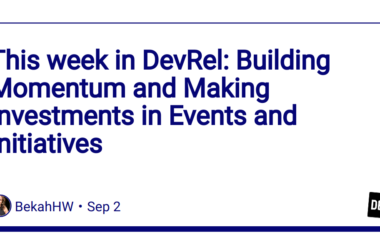TL;DR: This weekend I built ReelTrust a new type of video authentication software, which I hope others will either continue to expand upon it or build something better – ASAP.
ReelTrust is designed to:
- Prove a video’s source and authenticity.
- Protect that video against accusations of manipulation.
- Ensure that future doctoring is clearly detectable.
- Do all the above built on open source solution with transparency built in.
Under the hood, I treated this as a data engineering metadata pipeline problem: build the simplest-possible solution that handles huge audiovisual datasets efficiently, respecting privacy and security, with a focus on leveraging at scale for multiple audiences and use cases.
Why I built ReelTrust
For at least two years now, we’ve all known the AI technologies would be soon creating videos that look identical to real-life videos. And with Sora 2 now launched, we’ve woken up to find that that future is now. The news media (CNN, NYT, Reuters, etc) and media distribution industries (YouTube, TikTok, etc.) have collectively failed to prepare for our current reality. Not only a topic of news itself, I now regularly overhear people in coffee shops bemoaning that they “just can’t tell what is real any more”.
With things getting worse, and no plan in place, I finally felt I needed to invest some of my weekend hours and take some action myself.
How ReelTrust works
For those who just want to see some code, here’s what the CLI looks like today…
# Install uv if it's not installed already
brew install uv
# Create a verification package
uvx reeltrust create-package my-orig-video.mp4
# Verify the original video (passes)
uvx reeltrust verify my-orig-video.mp4 .data/outputs/packages/my-orig-video
# Verify a compressed/re-encoded video (passes)
uvx reeltrust verify my-video-compressed.mp4 .data/outputs/packages/my-orig-video
# Verify a clip taken from the original video (passes)
uvx reeltrust verify clip-from-my-video.mp4 .data/outputs/packages/my-orig-video
# Verify a doctored version of the original video (fails)
uvx reeltrust verify my-video-tampered.mp4 .data/outputs/packages/my-orig-video
# Verify a doctored clip taken from the original video (fails)
uvx reeltrust verify clip-from-my-video-tampered.mp4 .data/outputs/packages/my-orig-video
ReelTrust Rollout
Once an MVP (minimum viable product) is fully complete, ReelTrust would work in partnership across six parties:
- Video Content Creators (CNN, New York Times, White House Correspondents, etc.)
While capturing video, content creators pre-process their video and create a ReelTrust verification package. The verification package is a robust set of fingerprint metadata on the audio and video files.
Creators invest in some additional processing and storage costs, in exchange for an improved trust relationship with their customers and their end users (i.e. content consumers).
- Package Hosting and Indexing Providers (AWS S3)
In its simplest form, the verification package hosting service hosts packages in publicly accessible manner, such as a public S3 bucket or a public static site with the ability for users to list and download verification resources.
More advanced forms could provide a “find-by-clip” feature via advanced indexing, as well as services to privately store higher-res original video without surfacing that original content on the public internet.
All verification assets would be digitally signed at time of creation and/or at time of upload, providing proof of the video verification package’s creation time, geolocation, and contents.
Importantly, while fingerprint information may be freely hosted on public servers, the high fidelity content itself is not publicly shared. This allows the public to freely verify authenticity and also to detect manipulation, while not enabling others to steal their content.
- Video Distributors (YouTube, Facebook, TikTok)
Video distributors like YouTube would read their content creators’ metadata during the video upload process, compare with attached ReelTrust package URIs, and accept or reject the video publish based on verification results. Apart from rejecting outright, videos could also be allowed to be published regardless of verification status, while displaying to users the results of verification inline to the videos being consumed.
When no ReelTrust verification information is available, the experience for users may be exactly the same as their experience today – except for a blanket caveat that zero verification has been performed on the content’s authenticity. For positively confirmed verifications, the user would see something akin to a green checkmark or lock symbol (✅🔒) – with an option to view additional metadata on who created the original video, where and when it was authored, along with how exactly the videos contents were confirmed.
- Distributed Trust Authorities
Today the internet heavily relies on a network of distributed “CAs” or “Certificate Authorities” that certify a website is who it claims to be, and that known malicious actors are flagged as such. But while these Certificate Authorities don’t and can’t be responsible for flagging spreaders of disinformation – a new type of distributed ReelTrust Authorities (RTAs) can be responsible for analyzing trust statistics across content producers.
For instance, if an actor is found to have fraudulently certified a video, or is later found to have published fraudulent video in the guise of an authentic recording, their credibility ratings would be docked.
- Recording-device Manufacturers
As an optional but helpful additional measure, Content Creators should adopt hardware-level chips which can sign generated videos with the exact timestamps and geolocation tags which an AI or malicious human actor would not be able to fake. These technologies today are mostly used in security cameras, but for the highest levels of trust, these would be also carried into the professional recording devices, and maybe someday into consumer grade phones as well.
This additional hardware-level verification metadata would be carried and published with the rest of the ReelTrust verification package.
What does a future look like with ReelTrust?
The future with a system like ReelTrust would entail every important national event having signed, verified ReelTrust media certificates. Elections, interviews, news footage – it would all be certified and signed. Authentic footage of these events would be marked clearly as “✅🔒 ReelTrust Certified Video”. Dubious or unsigned footage would be marked as such, and even edited footage that was still authentic would be clearly marked as edited.
All of this would be built on lessons learned on how to build the same distributed trust foundation that we rely on daily today for safe online shopping, and to keep malware out of our emails.
What does the future look like if we do nothing?
If we do nothing, things continue to get much worse. Fake video will be presented as real, while authentic videos will be slandered as AI fakes. If we do nothing, we lose our ability as a society to believe our eyes. It’s already happening, so we need to act fast.
What is included in the Proof of Concept (POC)
I’m hosting on GitHub at https://github.com/aaronsteers/ReelTrust under the MIT license.
What it can do today is:
- Create verification packages that combine a low_res video digest along with a variety of video and audio fingerprints.
- Compare a given video against the verification package, printing a verification report and “PASS” or “FAIL” status of verification.
- Works on re-encoded or compressed videos as well as the original fidelity.
- Create 5-second side-by-side comparison clips where deviations are detected – comparing the evaluated video against the recorded low-res digest.
Tackling video authenticity as a data engineering problem
If you’ve worked with me, you know that video analysis is not my personal area of expertise – far from it! But data engineering is my expertise – and my approach was basically to approach video authenticity as a data engineering problem.
What’s being built:
- Composable pipelines to capture video/audio fingerprints.
- Frame-level metadata slices (SSIM, perceptual hashes, stats).
- CLI tools for verification, clip matching, and offset detection.
No AI/ML required (yet). Just reliable data structures, smart comparisons, and a heavy reliance on hashing, fingerprints, and clever vector embeddings.
Want to get involved?
My primary motivation in creating this project was to show (to myself, my friends, and the industry) that this is indeed possible, and that it is worth more investment.
Everything in the project is shared freely as open source. Feel free to fork the repo and improve it. Feel free to drop me a line if you want to talk. This was entirely created during my personal time, and I do want to see this become a reality.
Chime in below – do you think this is project overly ambitious – or too boring / obvious? Any fatal flaws in the approach? Is someone you know of already already building something similar to this?
Like or share so this can reach more eyeballs – and hopefully the industry partners that need to act eventually will.
Thanks!
-Aaron (AJ) Steers






